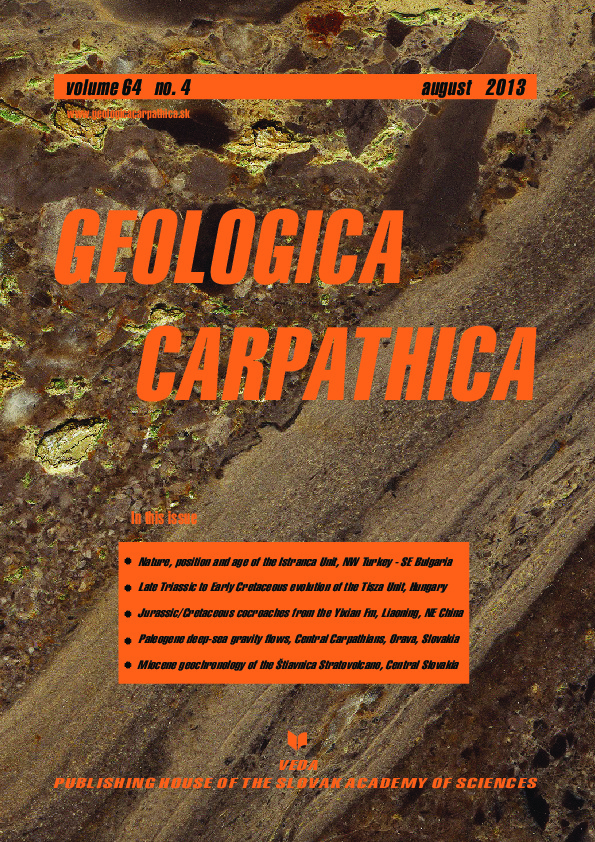Large-volume gravity flow deposits in the Central Carpathian Paleogene Basin (Orava region, Slovakia): evidence for hyperpycnal river discharge in deep-sea fans
Published: Aug 2013
Pages: 305 - 326
DOI: https://doi.org/10.2478/geoca-2013-0022
Authors: DUŠAN STAREK, JÁN SOTÁK, JOZEF JABLONSKÝ, RÓBERT MARSCHALKO
Abstract: The deep-water clastic systems of the Central Carpathian Paleogene Basin contain megabeds, which are devel- oped in distinctive stratigraphic horizons and can be traced over long distances. These beds are characterized by great individual thickness (4—13 m), uniform lithology and internal structures. On the basis of their lithology, sedimentary structures and sequence development, the megabeds are characterized by 15 individual facies and interpreted from the viewpoint of flow hydrodynamics. The grain-size distribution and internal structures of the megabeds point to their depo- sition from uniform turbulent flows. The main controlling factor for generation of such large voluminous flows is inferred in the sea-level changes, when a relative rising of sea level during the Eocene/Oligocene boundary was responsible for long-lasting accumulation of the clastic supply at the basin margins. The large volume of detritus from river discharge and ravinement surfaces of flooded land was accumulated on the shore and in the conduit heads where the sediment was remobilized by other triggers. The flows generated by catastrophic floods during the early Rupelian sea-level lowstand are thought to be the most probably triggering mechanism. The large highly erosive hyperpycnal flows from flooding rivers could erode accumulated deposits in the conduit or on steeper basin-margin slopes and could cause progressive increase of the sand volume in the flow. Conduit flushing appears to be the most probable source of sediment for the very large voluminous flows that were responsible for deposition of the Orava megabeds.
Keywords: Early Oligocene, Central Carpathians, megabeds, megaturbidites, hyperpycnal-flow deposits
Download PDF documentVolume 64 no. 4 / August 2013
YAVUZ BEDI, EMIL VASILEV, CHRISTO DABOVSKI, ALI ERGEN, CENGIZ OKUYUCU, ADIL DOGAN, U. KAGAN TEKIN, DARIA IVANOVA, ILIANA BONCHEVA, ISKRA LAKOVA, VALERI SACHANSKI, ISMAIL KUSCU, ERCAN TUNCAY, D. GÜLNUR DEMIRAY, HAVVA SOYCAN, M. CEMAL GÖNCÜOGLU
New age data from the tectonostratigraphic units of the Istranca “Massif” in NW Turkey: a correlation with SE BulgariaGÉZA CSÁSZÁR, BALÁZS SZINGER, OLGA PIROS
From continental platform towards rifting of the Tisza Unit in the Late Triassic to Early CretaceousDANDAN WEI, DONG REN
Completely preserved cockroaches of the family Mesoblattinidae from the Upper Jurassic-Lower Cretaceous Yixian Formation (Liaoning Province, NE China)DUŠAN STAREK, JÁN SOTÁK, JOZEF JABLONSKÝ, RÓBERT MARSCHALKO
Large-volume gravity flow deposits in the Central Carpathian Paleogene Basin (Orava region, Slovakia): evidence for hyperpycnal river discharge in deep-sea fansIGOR V. CHERNYSHEV, VLASTIMIL KONEČNÝ, JAROSLAV LEXA, VLADIMIR A.KOVALENKER, STANISLAV JELEŇ, VLADIMIR A. LEBEDEV, YURIJ V. GOLTSMAN
K-Ar and Rb-Sr geochronology and evolution of the Štiavnica Stratovolcano (Central Slovakia)




